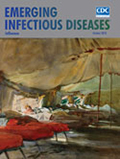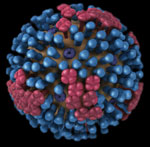
Volume 24, Number 10—October 2018
Etymologia
Etymologia: Hemagglutinin and Neuraminidase

Figure. Image of influenza virus showing hemagglutinin (blue) and neuraminidase (red) proteins on the surface of the virus. Content source: Centers for Disease Control and Prevention, National Center for Immunization and Respiratory...
In 1941, virologist George K. Hirst discovered that adding influenza virus to red blood cells (erythrocytes) in a test tube caused the cells to agglutinate, mediated by one of the virus surface glycoproteins, hemagglutinin (from the Greek haima, “blood,” + Latin gluten, “glue”) (Figure). Alfred Gottschalk later showed that hemagglutinin binds virus to host cells by attaching to sialic acids (from the Greek sialon, “saliva”) on carbohydrate side chains of cell-surface glycoproteins and glycolipids. The other influenza virus surface protein, neuraminidase (referring to brain lipids from which it was first derived) is a virus receptor-destroying enzyme that removes its substrate, sialic acids, from infected cell surfaces so that newly made progeny viruses are released to infect additional cells. At present, 18 hemagglutinin subtypes (H1–H18) and 11 neuraminidase subtypes (N1–N11) are recognized.
References
- Gottschalk A. The chemistry and biology of sialic acids and related substances. London: Cambridge University Press; 1960.
Figure
Cite This ArticleOriginal Publication Date: 9/4/2018






















.png)











No hay comentarios:
Publicar un comentario